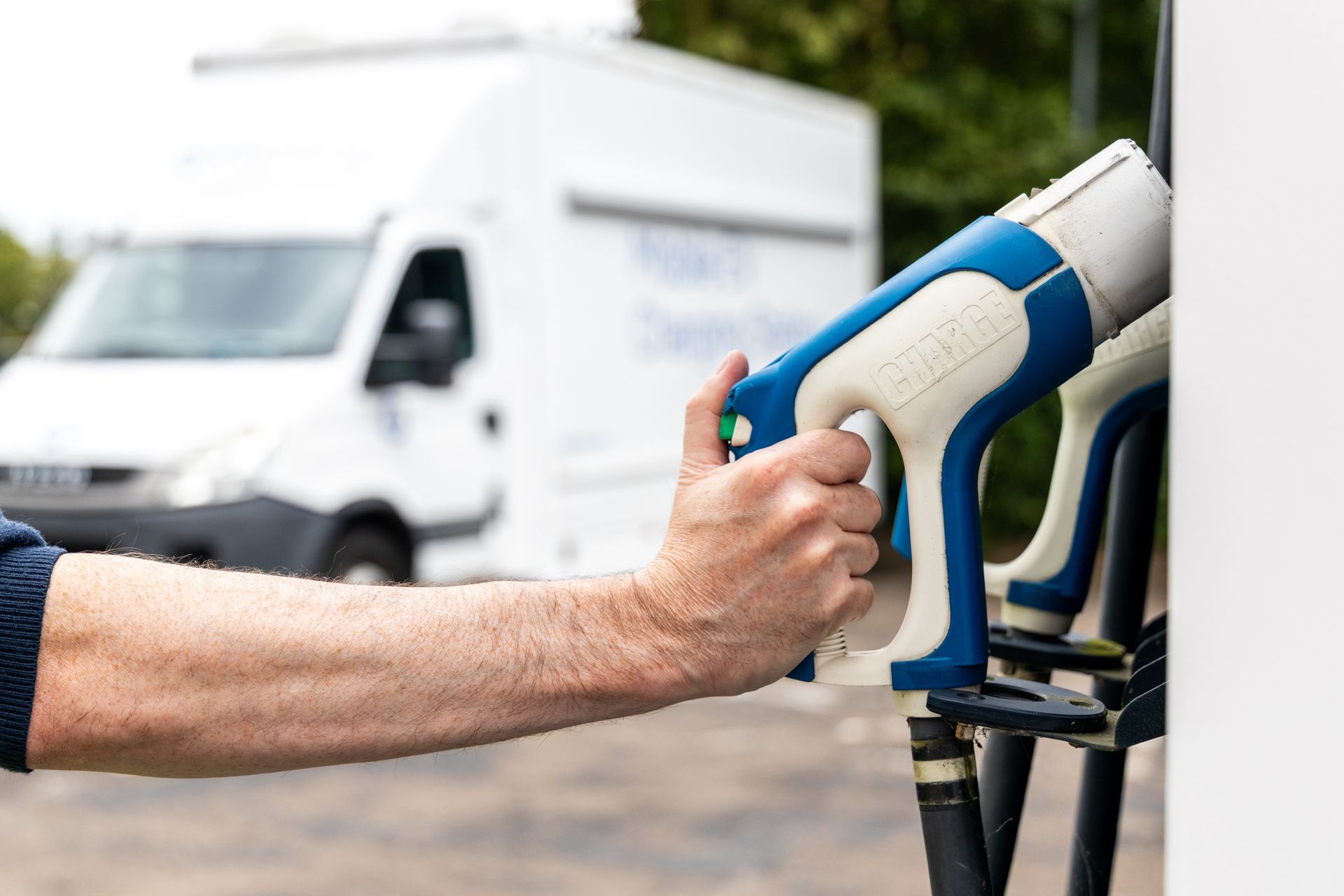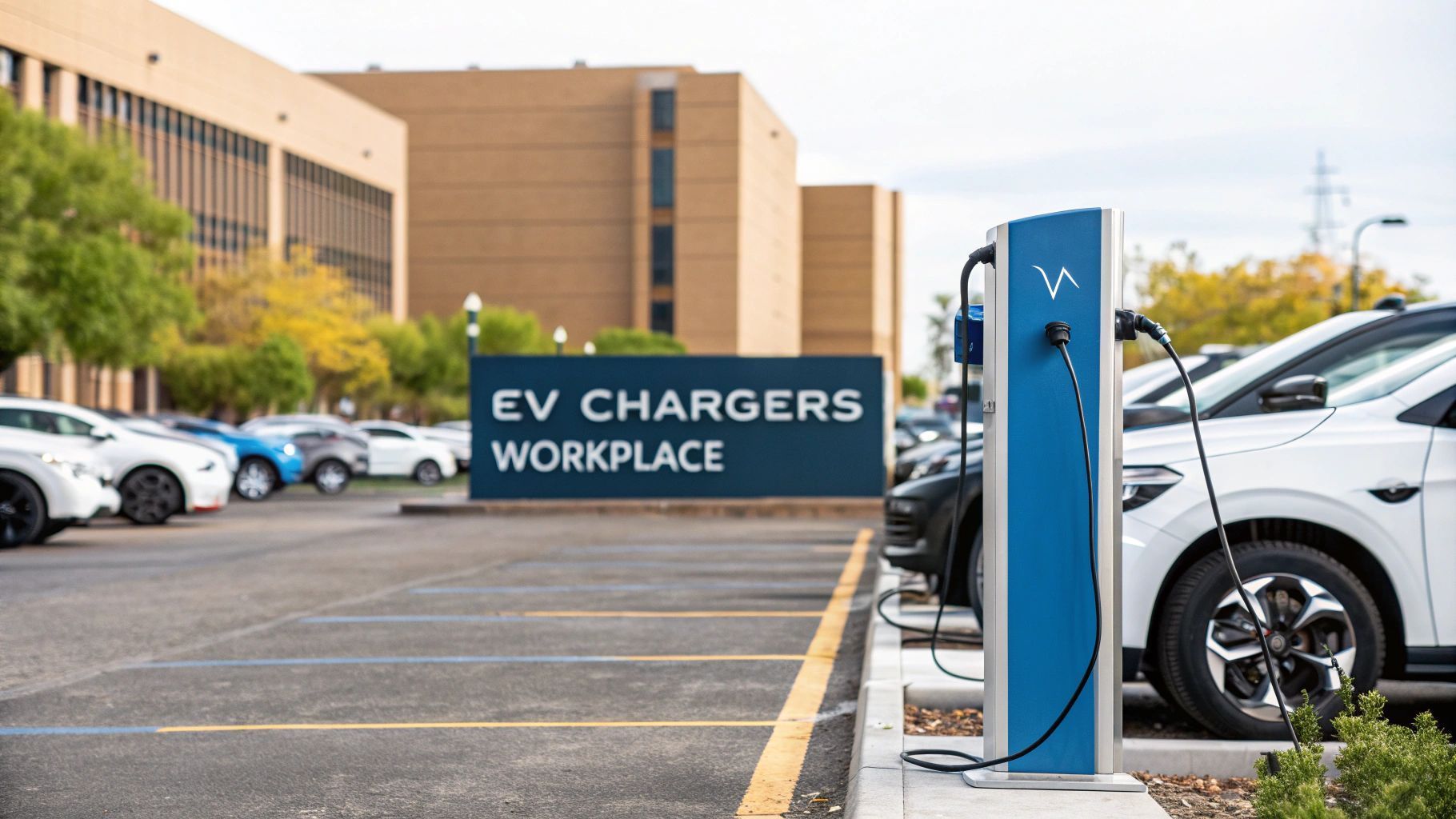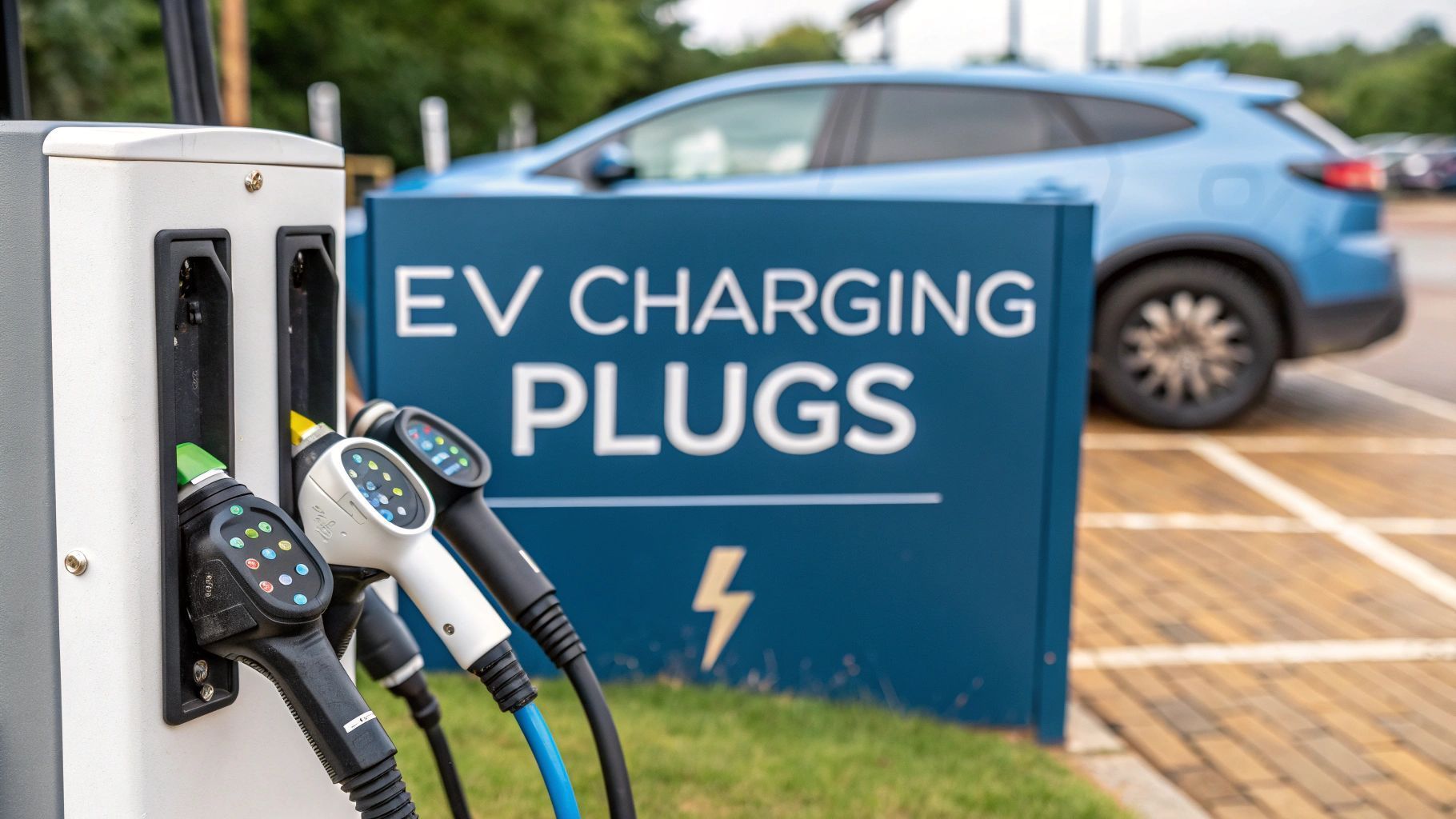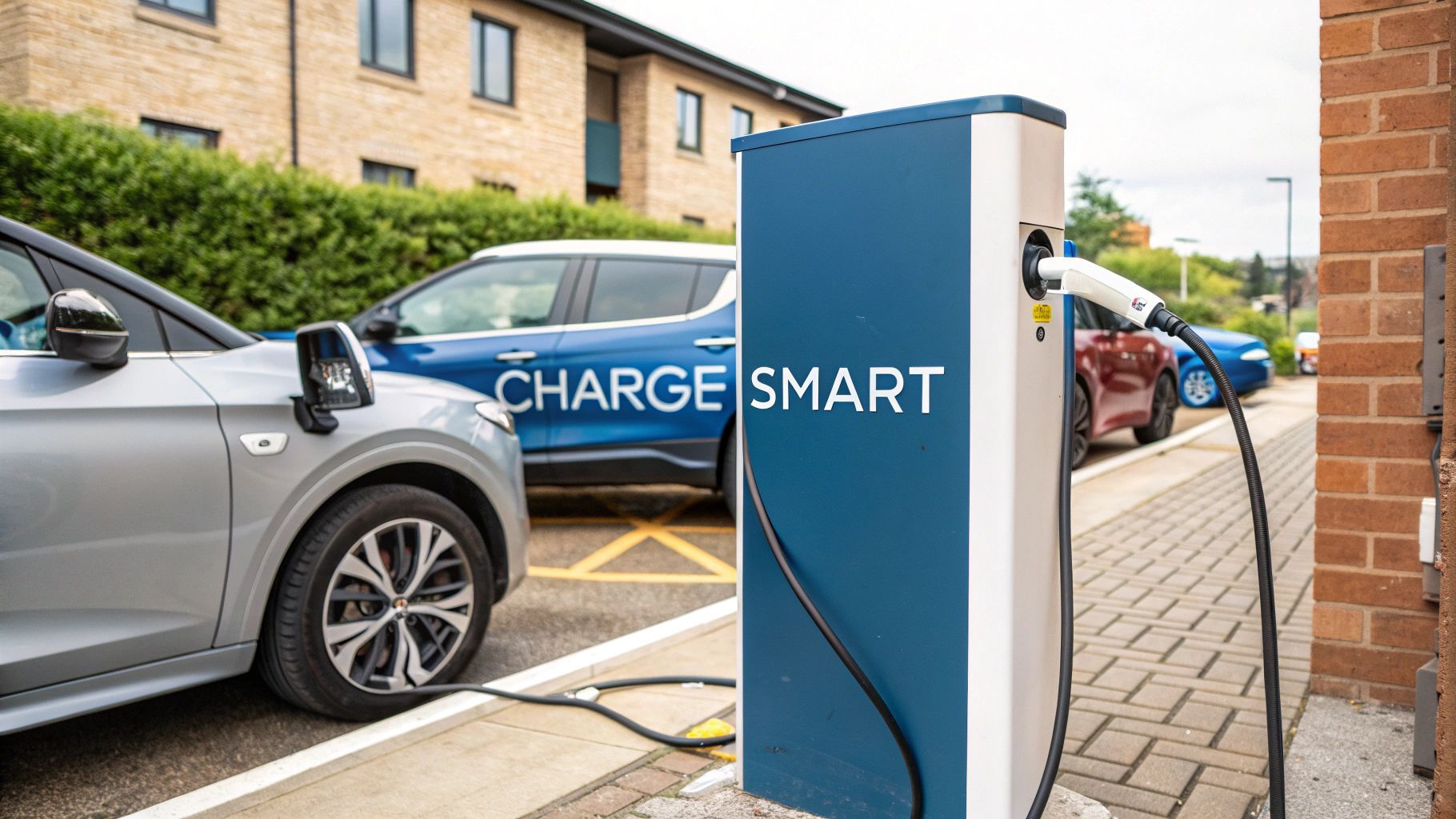UK Workplace Electric Vehicle Charging Guide
Offering workplace electric vehicle charging has quickly gone from a nice-to-have perk to a genuine strategic necessity for UK businesses. It is no longer just about sustainability credentials; it is about attracting top talent, future-proofing your operations and even opening up a new revenue stream. The real challenge is figuring out how to do it without the headache of costly, disruptive construction projects.
Why Mobile EV Charging Is a Business Game-Changer
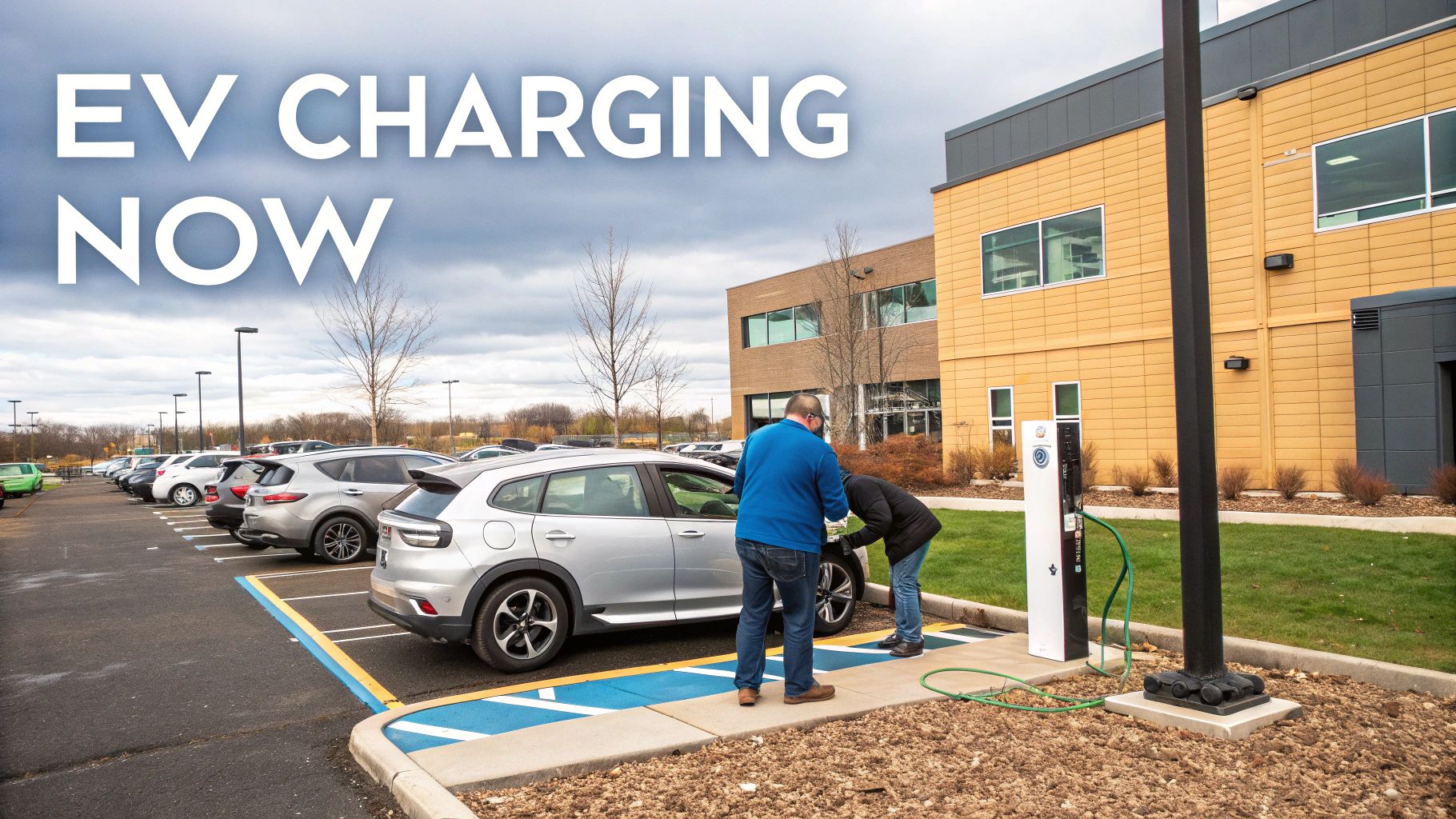
The demand for EV charging at work is not just growing; it is surging. Recent data shows that workplaces are the second most common place for drivers to top up, right behind their own homes. Suddenly, not providing this facility can put you at a competitive disadvantage.
For many companies though, the thought of digging up the car park and getting tangled in complex planning permissions for fixed charging points is a complete non-starter. This is where mobile charging solutions offer a much smarter path forward. Instead of a massive capital project, you can roll out a flexible, scalable service with minimal upfront cost and turn a company expense into a significant source of profit.
Turn a Cost Centre into a Profit Centre
Perhaps the most compelling argument for operating a mobile charger is its potential as a revenue stream. You are not just providing a service—you are running a small, profitable enterprise right on your own property. By buying electricity at your commercial rate and selling it to employees or visitors at a competitive retail price, you create a direct profit margin on every kilowatt-hour.
The model is incredibly straightforward. Let's say your business pays 25p per kWh for electricity and you set the charging price for drivers at 50p per kWh . Simple as that, you have made a 100% markup on the energy sold . This flips your company car park, traditionally just an expense line, into a source of income.
Unlocking Significant Earning Potential
So, how much can you realistically make? Let's break down a simple scenario. Imagine a single mobile charger services just four vehicles a day, each needing a 30 kWh top-up (that is 120 kWh in total). The returns can be surprisingly substantial.
With a profit margin of 25p per kWh, the daily earnings from this modest usage would be £30. Over a standard five-day working week, that adds up to £150 in pure profit . Annually, this one unit could generate over £7,000 .
This income comes without any of the long-term commitments or site disruptions that come with fixed installations, making it an incredibly attractive business proposition. The flexibility of a mobile solution means you can start earning immediately and scale up as demand grows, maximising your financial return with minimal risk.
The Mobile EV Charging Advantage Over Fixed Units
When businesses start exploring workplace electric vehicle charging, they often hit the same wall: the sheer disruption and cost of installing fixed units. Traditional chargers do not just come with a hefty price tag; they demand groundwork, planning permissions and a long-term commitment to one specific parking spot.
This is where mobile charging completely changes the game.
It is a lifesaver for businesses in leased properties or those on temporary sites where digging up the car park just is not an option. Instead of being locked into a permanent setup, mobile units let you turn any standard parking space into an on-demand charging hub. All with minimal upfront cost and zero construction headaches.
Lower Costs and Faster Deployment
Let's talk numbers because the difference between mobile and fixed charging is stark. A permanent charger installation can easily spiral upwards of £20,000 and take months to get from the initial survey to the final sign-off.
In sharp contrast, you could have a high-quality mobile charger up and running for a fraction of that cost, often in a single day.
This infographic breaks down the initial investment, deployment time and site flexibility for both options.
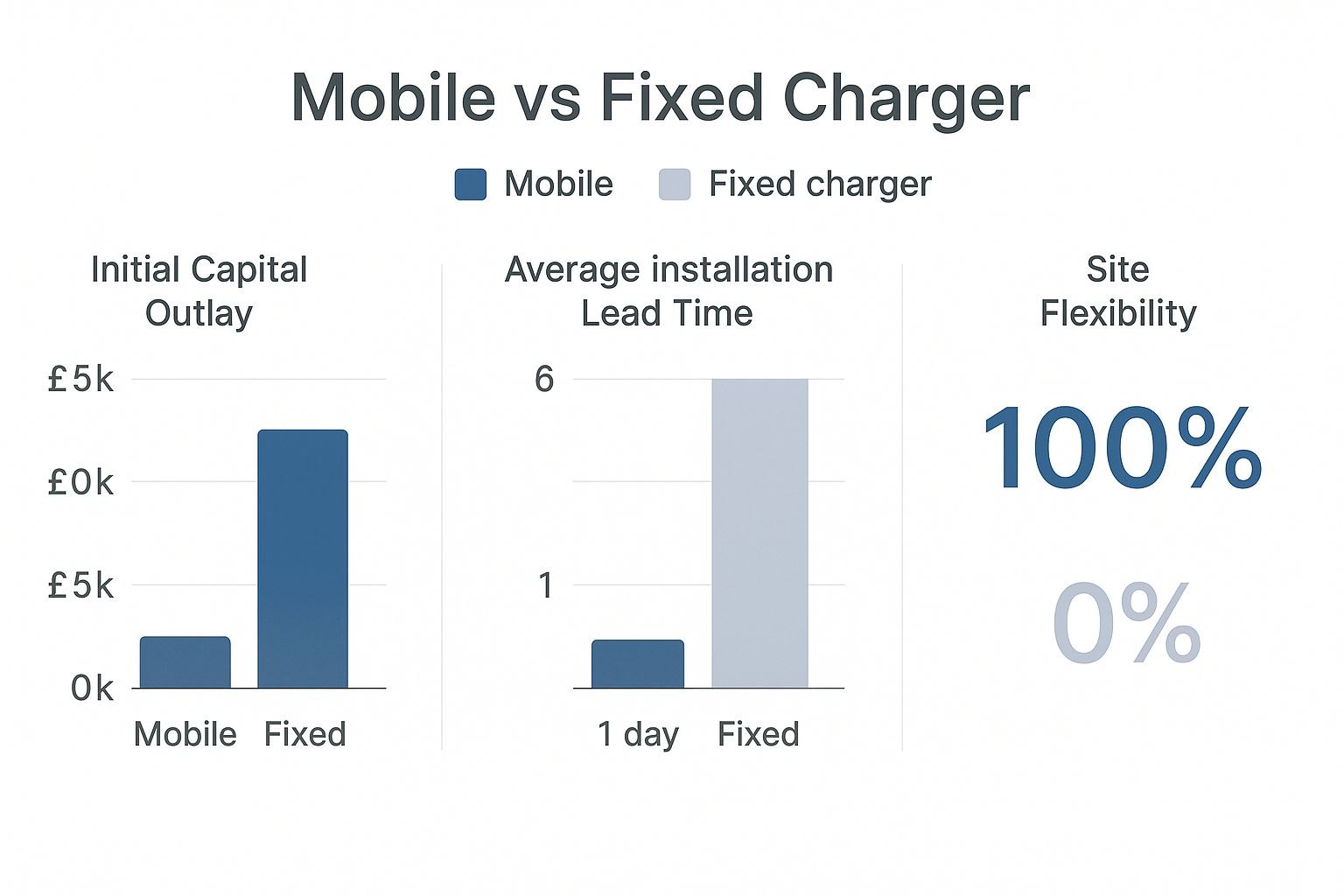
The data makes it clear: mobile units offer an immediate, cost-effective solution with the kind of flexibility that works for almost any business location.
Creating a Lucrative Business Model
Beyond the initial savings, a mobile charger opens the door to a surprisingly profitable business model. The principle is incredibly simple: buy electricity at your commercial rate and sell it to drivers at a competitive price per kWh.
This approach does not just cover the equipment cost over time—it actually generates a steady, reliable income stream.
For example, if your business electricity tariff is 25p per kWh and you set a charging rate of 50p per kWh for employees, you have just achieved a 100% markup . Your car park has gone from being a simple amenity to an active revenue generator.
This model is becoming more and more popular as the demand for workplace charging explodes. The UK's EV charging market is gearing up for massive growth, with projections showing the number of units jumping from around 50,640 in 2024 to an estimated 169,150 by 2030 . This boom is being driven by savvy businesses investing in flexible solutions to meet employee and fleet needs.
The beauty of this is its scalability. You can start with just one unit and add more as demand grows, all without needing to plan for major new infrastructure.
Of course, if you are considering significant site modifications, understanding the process of tenant finish projects for commercial spaces can be incredibly helpful for planning. But before you get to that stage, it is crucial to weigh your options. You can dive deeper into the future of EV charging with our comparison of stationary vs mobile solutions.
Projecting Your Mobile Charging Revenue
Ready to turn your car park into a genuine profit centre? It all starts with the numbers. Projecting your potential earnings from a mobile charging service is surprisingly straightforward but you need a crystal-clear view of your costs, pricing and expected usage.
This is not just about offering another staff perk; it is about building a solid financial case for your investment in workplace electric vehicle charging .
The core of the business model is simply the margin you make on electricity. You buy energy at your commercial rate and sell it to drivers at a competitive, convenient price. That simple transaction is where all your revenue comes from.
Calculating Your Core Profit Margin
First things first, let's nail down the two most important figures: your cost per kilowatt-hour (kWh) and your selling price per kWh. Your business electricity bill will tell you exactly what you are paying—let's say it is around 25p per kWh . That is your baseline.
Next, you need to set a price for drivers. A quick bit of research on local public charging points will show you the going rate. To make your service an easy choice, you could set your price just below the public average, maybe at 50p per kWh . The difference between those two numbers is your gross profit margin.
Your Pricing Formula:
(Your Price per kWh) – (Your Electricity Cost per kWh) = Profit per kWhExample: 50p – 25p = 25p Profit per kWh
This 25p margin is the foundational number for all your revenue projections. If you want to dive deeper into this crucial metric, you can learn more about how to calculate a kilowatt-hour and its impact on your business.
Modelling Your Potential Income
Once you have got your profit margin, you can start modelling potential earnings. The key here is to be realistic. Do not assume every EV owner will use the service from day one. Instead, start by estimating how many employees might use it each day.
Let’s walk through a conservative example for a small to medium-sized business.
- Vehicles Charged Daily: Assume you start by servicing just 4 vehicles per day.
- Average Top-Up: A typical commuter might only need a 30 kWh top-up to cover their journey and daily driving.
- Total Energy Sold Daily: 4 vehicles x 30 kWh = 120 kWh .
Using our 25p profit margin, the daily earnings are simple to work out.
Daily Profit: 120 kWh x £0.25 = £30
Now, £30 a day might not sound like a game-changer but it adds up fast. Over a five-day working week, that is £150 in pure profit . Annually, that single mobile unit could generate over £7,000 for your business with minimal operational effort.
To give you a clearer picture of how this can scale, let's look at some projections.
Sample Weekly Revenue Projection For A Mobile EV Charging Operator
This table illustrates potential earnings for an operator based on different numbers of vehicles charged per day, showcasing the scalability of the business model.
| Vehicles Charged Per Day | Average Charge per Vehicle (kWh) | Price per kWh (Your Rate) | Electricity Cost per kWh | Daily Profit | Weekly Profit (5-Day Week) |
|---|---|---|---|---|---|
| 4 | 30 | £0.50 | £0.25 | £30.00 | £150.00 |
| 8 | 30 | £0.50 | £0.25 | £60.00 | £300.00 |
| 12 | 30 | £0.50 | £0.25 | £90.00 | £450.00 |
| 16 | 30 | £0.50 | £0.25 | £120.00 | £600.00 |
| 20 | 30 | £0.50 | £0.25 | £150.00 | £750.00 |
As you can see, the revenue potential grows directly with usage. As more staff switch to EVs and your service becomes established, the financial returns become increasingly attractive.
Advanced Pricing Strategies To Maximise Earnings
Once your service is up and running, you can get a bit more creative with your pricing to boost revenue even further. A one-size-fits-all approach works well at the start but tailoring your rates can attract more users and increase profitability.
Consider a few of these smart pricing options:
- Tiered Pricing: Offer different rates for employees and visitors. Staff could get a preferential rate as a perk, while visitors pay a price closer to what public charging networks charge.
- Premium Valet Service: Why not charge a small premium for the sheer convenience of having the mobile charger brought directly to a user's vehicle? This 'valet' option adds a layer of convenience that many busy professionals would happily pay for.
- Off-Peak Discounts: If your commercial electricity tariff offers cheaper rates overnight, you could offer lower-priced charging for any company fleet vehicles parked on-site after hours.
By thinking strategically about your pricing, you can transform a simple amenity into a sophisticated and highly profitable part of your business operations.
Securing UK Grants and Financial Support
Getting a workplace electric vehicle charging service off the ground takes more than just the right kit; it needs a solid financial game plan. The good news for UK businesses is that there is significant support available to take the sting out of the initial investment, making your project viable from day one.
While navigating the world of grants can feel a bit overwhelming, getting to grips with the key schemes is the first step. Done right, you can launch your service with minimal capital outlay.
Understanding The Workplace Charging Scheme
The main source of support you will want to look at is the government’s Workplace Charging Scheme (WCS). It is specifically designed to help businesses like yours install charging infrastructure for employees and company fleets.
Administered by the Office for Zero Emission Vehicles (OZEV), the WCS uses a simple voucher system that dramatically cuts the cost of installing chargepoints. It is a powerful tool for any business looking to switch to electric. To give you an idea of its impact, OZEV statistics from July 2025 showed the WCS had already funded thousands of chargepoints at workplaces right across the UK. You can dig into the latest electric vehicle charging grant scheme statistics on GOV.UK for the full picture.
The financial help is pretty substantial:
- Cost Reduction: The grant covers up to 75% of the total costs for buying and installing the chargepoints.
- Generous Cap: This support is capped at £350 per socket .
- Scalable Support: You can claim for up to a maximum of 40 sockets across all your business sites.
So, for a project with 10 sockets , you could get up to £3,500 in funding. That makes a huge difference to your initial budget. It is always worth checking the latest OZEV guidelines to confirm your eligibility though, as the rules can change.
While the WCS is often talked about for fixed installations, it can also cover the electrical work needed for mobile charging solutions. This includes installing the dedicated external sockets you need to charge the mobile units themselves.
Exploring Alternative Funding Avenues
Government grants are a fantastic starting point but they do not have to be your only option. To cover any remaining costs or to fund an even bigger project, it is smart to look at other financial routes.
Many UK banks now offer green business loans with favourable terms for projects that boost your sustainability credentials. It is definitely worth a conversation with your bank.
Another great strategy is to look into strategic partnerships. Energy providers are often keen to support businesses adopting EV tech and might offer special deals on equipment or electricity tariffs. Taking some time to explore the different finance options for EV chargers will give you a complete picture of what is out there.
By combining these different funding methods, you can make sure your project is well-supported and financially sound right from the start.
Launching Your Mobile Charging Service
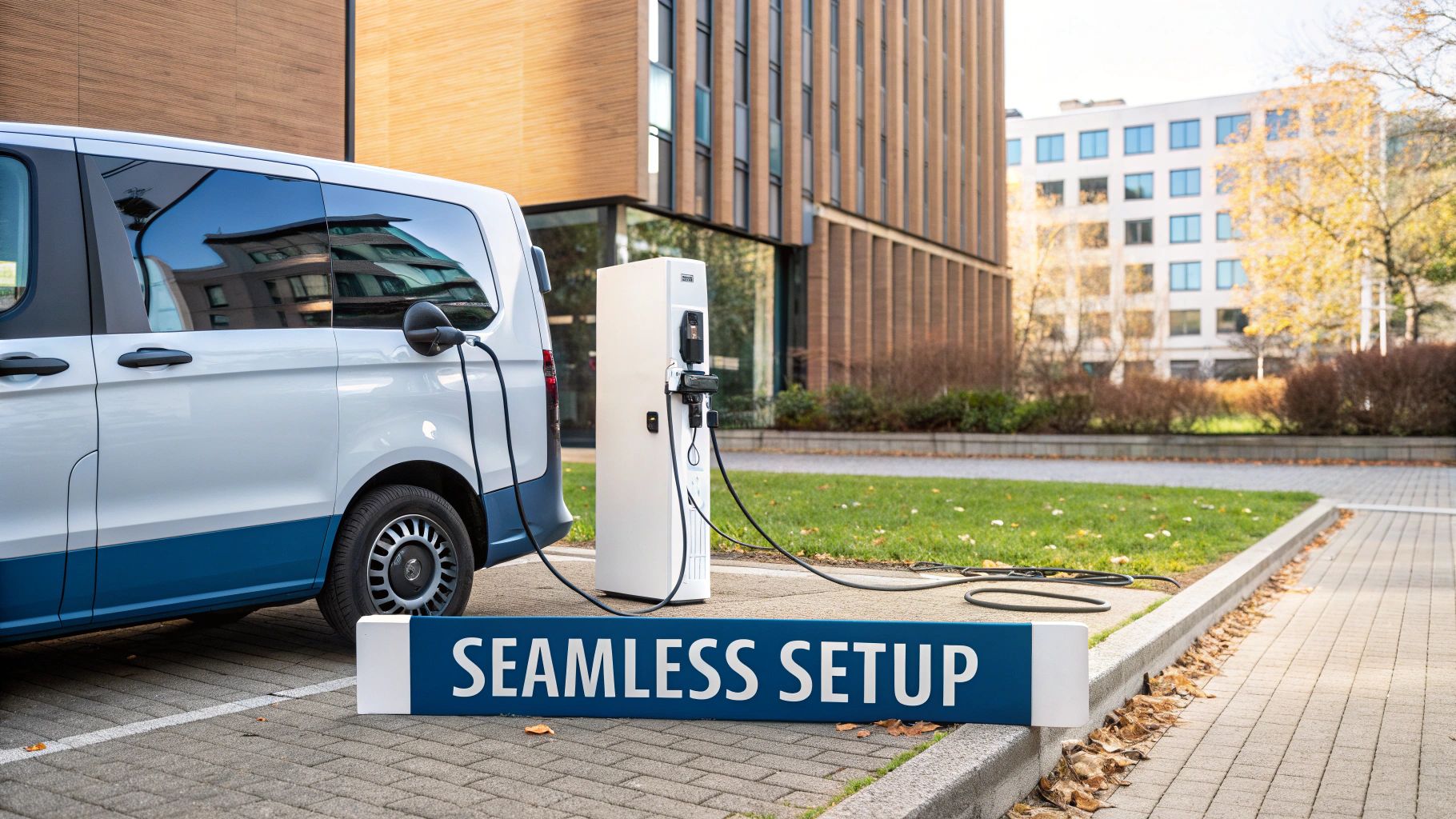
With funding secured and a solid revenue plan in place, it is time to get down to the brass tacks of running your mobile charging operation. This is the point where your business case transforms into a smooth, efficient service that benefits both your employees and your bottom line.
Nailing the day-to-day logistics is what separates a good idea from a great workplace electric vehicle charging service.
First things first, you need to choose the right gear. Mobile chargers are not a one-size-fits-all solution, so you will want to look closely at factors like charging speed, battery capacity and how easy the unit is to move around. Think about your specific needs: are you servicing a handful of cars each day or managing a much larger fleet? Your choice here will impact everything from turnaround times to the overall user experience.
Selecting The Right Equipment
When you are comparing different mobile chargers, it is smart to focus on a few key features that really matter in a workplace setting.
- Charging Speed (kW): A higher kW rating means faster charging. A 7kW unit is perfectly fine for a standard workday top-up but a 22kW or 50kW unit can deliver a significant charge much more quickly, offering a more premium service.
- Battery Capacity (kWh): This is all about how many vehicles you can service before the mobile unit itself needs a recharge. A larger capacity means less downtime for the unit and more charging availability for your team.
- Ease of Use: Look for something with intuitive controls and a clear display. You will also want a robust design that your staff can easily wheel around the car park without any hassle.
When you are thinking about the technical side of deployment, even for mobile units, it helps to have a basic understanding of your building's systems. Getting familiar with the essentials of MEP in construction —that is Mechanical, Electrical and Plumbing—can give you a better grasp of your site's capabilities.
Managing Your Day-To-Day Operations
Once you have your equipment, you need a simple, frustration-free system for managing the service. An effective booking process is vital if you want to avoid chaos. This could be as straightforward as a shared digital calendar or a dedicated channel on your company's internal messaging app where employees can request a slot.
It is also a good idea to establish designated charging zones in your car park. Yes, the chargers are mobile but having specific areas for charging helps manage traffic flow and keeps everything safe and organised. This small step makes the whole process predictable for everyone involved.
The UK's charging infrastructure is growing at an incredible pace. By 2025, over 75,000 public EV chargers had been installed, marking a 28% year-on-year increase . Workplace charging is a huge part of this expansion, especially for employees who rely on off-street parking.
Setting Up Payments And Safety Protocols
A seamless payment process is non-negotiable. Many modern mobile chargers come with integrated payment systems that can take contactless cards or mobile app payments, which removes any administrative headache from your team.
Do not forget the essentials: create a clear set of safety guidelines for operating the equipment and schedule regular maintenance checks. Proactive maintenance prevents unexpected failures and ensures your service remains reliable and safe for all users.
Answering Your Key Questions

As you get closer to rolling out a mobile workplace electric vehicle charging service, a few practical questions are bound to pop up. Getting these sorted will help you launch with confidence and create a profitable operation from day one.
One of the biggest hurdles with fixed installations is the red tape. But with a truly mobile solution? You skip most of it. Mobile units are typically classed as equipment, not permanent structures, which is a crucial distinction. In most cases, it means you do not need planning permission to get started.
This simple fact can save you months of potential delays. Of course, if you decide to install a dedicated socket on-site to charge the mobile unit itself, you will still want to have a chat with a qualified electrician first.
Pricing And Profitability
The big question is always about the numbers. How do you price the service to be both profitable and attractive to your staff? The simplest way is to look at what local public chargers are charging. Then, set your price per kilowatt-hour just a fraction below theirs. It is an instant, tangible perk for your team.
A price point somewhere between 45p and 60p per kWh usually hits the mark. It provides genuine value to employees while giving you a healthy margin over your own electricity costs. Suddenly, your car park is a reliable revenue source.
Remember, the goal is to create a business model where every charge contributes directly to your bottom line. A well-priced service ensures steady usage and maximises your earning potential without deterring employees.
Insurance And Liability Considerations
Finally, let's talk about insurance. It is a must-do. You will need to let your business liability insurance provider know you are adding an EV charging service. Your existing policy will almost certainly need an update to cover any potential incidents.
When you speak to your insurer, make sure you cover:
- Public liability for any accidents involving the equipment.
- Equipment insurance to protect the mobile unit against damage or theft.
Using certified equipment from a reputable supplier and establishing clear, simple safety protocols are the best ways to minimise your risk. This ensures your new venture is not just profitable but also safe and properly insured from the get-go.
Ready to transform your workplace car park into a profit centre with a flexible, hassle-free charging solution? Explore the mobile charging units from ZAPME and see how easy it is to get started. Find out more at https://www.zapme.biz.

